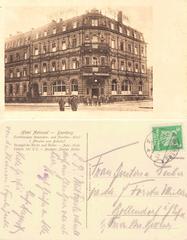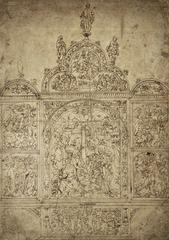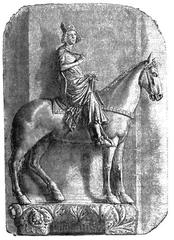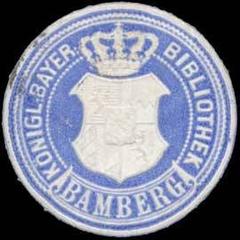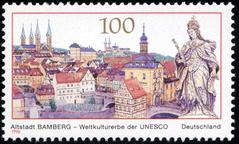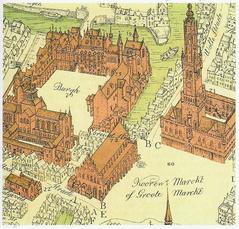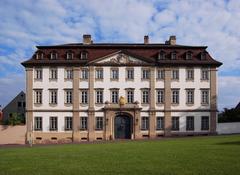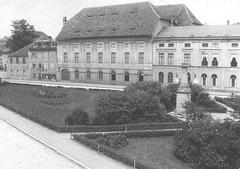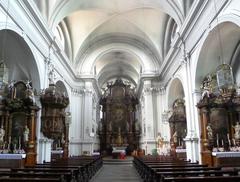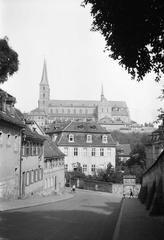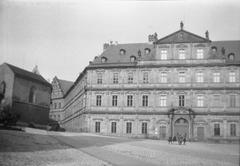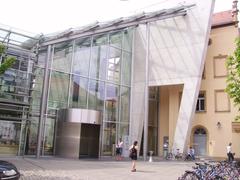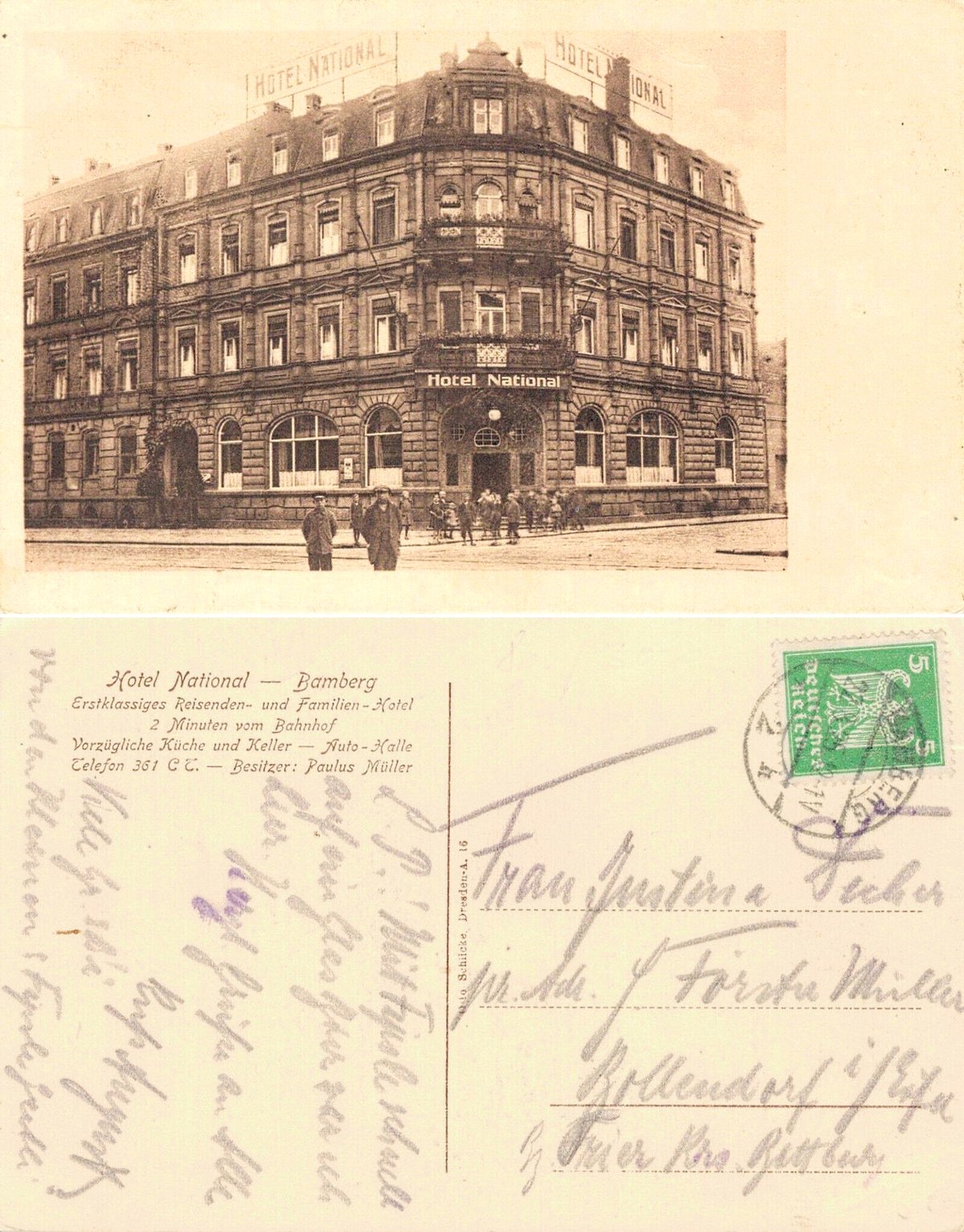
Luitpoldstraße 37 Bamberg, Germany: Visiting Hours, Tickets, and Historical Sites Guide
Date: 14/06/2025
Introduction: Luitpoldstraße 37, Bamberg—History and Cultural Significance
Nestled in the heart of Bavaria, Luitpoldstraße 37 in Bamberg is a gateway to one of Europe’s most captivating medieval cities. Bamberg, a UNESCO World Heritage Site, is renowned for its exceptionally preserved medieval urban structure, baroque architecture, and a rich cultural history spanning over a millennium. Luitpoldstraße, a prominent avenue that connects Bamberg’s central train station to the historic Old Town, is a vibrant mix of modern commerce and deep historical roots (worldheritagesites.net, Germany Destinations).
This guide explores the importance of Luitpoldstraße 37, home to the Hotel National, and its strategic location for visitors eager to immerse themselves in Bamberg’s heritage. The street’s late 19th- and early 20th-century architecture harmonizes with the medieval and baroque surroundings, providing a glimpse into the city’s evolution from a medieval bishopric to a vibrant modern destination (Nomads Travel Guide, LUI ONE Project).
With easy access to attractions such as the Bamberger Dom (Bamberg Cathedral), Altes Rathaus (Old Town Hall), and the Neue Residenz, visitors are perfectly placed to experience Bamberg’s rich art and history. This guide offers essential information about visiting hours, ticketing, accessibility, transportation, and local events to help travelers plan their visit efficiently (ostrichtrails.com, bamberg.info).
Whether wandering the Altstadt’s cobblestone streets, indulging in Franconian cuisine, or exploring Bamberg’s renowned beer culture, Luitpoldstraße 37 is the ideal base for discovering Bamberg’s living heritage.
Contents Overview
- Introduction
- Historical and Cultural Context of Luitpoldstraße and Bamberg
- Medieval Origins and Urban Development
- Religious and Political Significance
- Urban Planning and Architectural Heritage
- Practical Visitor Information: Visiting Hours, Tickets, Accessibility
- Cultural Life and Everyday Experience
- Notable Nearby Historical Sites
- Visitor Tips and Transportation
- Visuals and Interactive Resources
- Luitpoldstraße 37: Accommodation, Urban Integration, and Historical Highlights
- Bamberg’s Historical Treasures: Bamberger Dom, Altes Rathaus, Neue Residenz
- Key Attractions, Events, and Local Tips Near Luitpoldstraße 37
- Summary and Recommendations
- Sources and Further Reading
Visiting Luitpoldstraße: History, Visitor Tips, and Attractions
Historical and Cultural Context
Medieval Origins and Urban Development
Bamberg’s urban landscape reflects its medieval origins, with much of the city’s layout and architecture preserved since the Middle Ages. The city’s rise began in 1007, when Holy Roman Emperor Heinrich II established the Bishopric of Bamberg, transforming it into a religious, political, and cultural center (1xmarketing.com). Luitpoldstraße, running parallel to the Regnitz River, connects the train station to the UNESCO-listed Altstadt, recognized since 1993 for its outstanding preservation and influence on Central European urban planning (worldheritagesites.net).
Named after Prince Regent Luitpold of Bavaria, the street’s architecture from the late 19th and early 20th centuries is seamlessly integrated with Bamberg’s medieval and baroque cityscape.
Religious and Political Significance
Envisioned as a “second Rome” and built on seven hills, each crowned by a church (mygermancity.com), Bamberg’s skyline is dominated by the four-towered Bamberger Dom, which houses the tombs of Emperor Heinrich II and Kunigunde (ostrichtrails.com). Luitpoldstraße’s proximity to these landmarks underscores its importance as a connector between Bamberg’s civic and sacred spaces.
Historically, Bamberg was governed by prince-bishops with both secular and ecclesiastical power. Their political center, the Neue Residenz, remains a key city landmark (residenz-bamberg.de).
Urban Planning and Architectural Heritage
Bamberg’s urban layout follows medieval planning principles, with major churches at the cardinal points (worldheritagesites.net). Luitpoldstraße was developed during the 19th-century expansion, adapting to modern transportation and commerce while preserving historical integrity. The street is characterized by ornate facades and decorative stonework that reflect the city’s growing middle class and the influx of visitors arriving by train after 1844 (mygermancity.com).
Practical Visitor Information
- Visiting Hours: Luitpoldstraße is a public street accessible 24/7. Shops, cafes, and hotels generally operate between 9:00 AM and 8:00 PM.
- Tickets: No tickets are required to visit Luitpoldstraße itself. Admission may apply to nearby attractions like Bamberg Cathedral and Neue Residenz.
- Guided Tours: Available through the Bamberg Tourist Information Center and local providers.
- Accessibility: The street is mostly flat and pedestrian-friendly, with accessible public transportation and facilities nearby.
- Events: Seasonal markets and cultural festivals are held throughout the year; check local calendars for current events.
Cultural Life and Everyday Experience
Today, Luitpoldstraße is a lively artery lined with historic buildings housing shops, cafes, and hotels (timetravelturtle.com). Its proximity to the Gärtnerstadt (Gardener’s District)—a living urban agricultural zone since the Middle Ages—adds to its unique character (worldheritagesites.net).
Notable Nearby Historical Sites
- Bamberg Cathedral (Bamberger Dom): Renowned Romanesque-Gothic church with imperial tombs and the Bamberg Horseman statue (ostrichtrails.com).
- Altes Rathaus (Old Town Hall): Striking building on an island with vivid frescoes (1xmarketing.com).
- Neue Residenz and Rose Garden: Former prince-bishops’ residence with panoramic views (residenz-bamberg.de).
- Gärtnerstadt: Gardener’s District with museums and working gardens (worldheritagesites.net).
Visitor Tips and Transportation
Luitpoldstraße is easily reached from Bamberg’s train station, with clear signage leading to the Old Town. Walking tours from Luitpoldstraße 37 to major attractions typically take 15-20 minutes (ostrichtrails.com). Public buses connect the area to outlying districts and Seehof Palace.
The tourist information center offers maps, guided tour bookings, and advice on events (bamberg.info). Accommodation options range from budget hotels to boutique guesthouses (timetravelturtle.com).
Visuals and Interactive Resources
Online maps, virtual tours, and high-quality images of Luitpoldstraße and nearby landmarks are available through Bamberg’s official tourism websites. Descriptive alt tags such as “Luitpoldstraße visiting hours” and “Bamberg historical sites” improve accessibility and searchability.
Luitpoldstraße 37: Accommodation, Urban Integration, and Historical Highlights
Historical Context and Urban Development
Luitpoldstraße 37, now home to the Hotel National, exemplifies Bamberg’s evolution from a medieval city to a modern urban center (Germany Destinations). Developed during the late 19th and early 20th centuries, the area reflects Bamberg’s adaptation to increased travel and commerce following the arrival of the railway (Nomads Travel Guide).
Architectural Features
The building at Luitpoldstraße 37 showcases early 20th-century German urban architecture, with clean lines, large windows, and minimal decorative elements. It harmonizes with neighboring structures and the broader streetscape (LUI ONE Project). The hotel’s interior features modern amenities while retaining aspects of its historic character.
Visiting Hours and Tickets
Hotel National (Luitpoldstraße 37) is a private accommodation and does not have public touring hours. Access to the hotel’s public spaces is for guests and visitors using its amenities. The surrounding street and public areas are open year-round (Germany Destinations).
Urban Integration and Accessibility
Luitpoldstraße 37 enjoys a prime location, linking the train station with the old town. The area offers pedestrian-friendly sidewalks, bike lanes, and excellent public transport connections (LUI ONE Project). Sustainable urban initiatives, like LUI ONE, enhance green spaces and promote car-free zones.
Role in Bamberg’s World Heritage Status
Although outside the UNESCO-listed medieval core, Luitpoldstraße 37 supports heritage tourism by providing essential infrastructure. The building’s integration helps ensure modern development complements Bamberg’s historic character (UNESCO World Heritage).
Amenities and Proximity to Attractions
- Hotel National: Contemporary rooms, free Wi-Fi, on-site dining, and business facilities.
- Nearby Attractions: Bamberg Cathedral (1.5 km), Altes Rathaus (15-minute walk), Grüner Markt, Schlenkerla Brewery (Germany Destinations).
- Transportation: 300 meters from the train station, multiple bus lines, and bicycle facilities (LUI ONE Project).
- Nearby Services: Shops, supermarkets, restaurants, and public offices.
Sustainable Urban Features
Recent developments emphasize resource-efficient construction, green spaces, and pedestrian and bicycle-friendly zones (LUI ONE Project).
Exploring Bamberg’s Historical Treasures
Bamberger Dom (Bamberg Cathedral)
A highlight of Romanesque and Gothic architecture, the cathedral houses the tombs of Emperor Henry II and Pope Clement II, and features the famous Bamberg Horseman statue. Open daily, generally 9:00 AM to 6:00 PM (bamberg.info).
Altes Rathaus (Old Town Hall)
Perched over the Regnitz River, this 14th-century building dazzles visitors with its frescoes and baroque interiors. Museum hours are Tuesday–Sunday, 10:00 AM–5:00 PM.
Neue Residenz and Rose Garden
The former prince-bishops’ residence is open daily, 10:00 AM–5:00 PM, and features splendid rooms and a celebrated rose garden.
Key Attractions, Events, and Local Tips Near Luitpoldstraße 37
Attractions
- Bamberg Old Town (Altstadt): UNESCO-listed, with medieval streets and Klein-Venedig on the river.
- Michaelsberg Monastery: Panoramic views and museum.
- Altenburg Castle: 12th-century fortress accessible by car, bus, or hiking.
- Breweries: Bamberg’s nine breweries produce over 50 beer varieties, including the famous Schlenkerla smoked beer.
Amenities and Services
- Hotel National: Comfortable accommodation at Luitpoldstraße 37.
- Nearby Restaurants and Cafes: Includes Franconian, Spanish, and Chinese cuisine.
- Shops: Supermarkets, pharmacies, bakeries, and the zero-waste Unverpackt Bamberg.
- Transport: Central train station (340 meters), bus stops, and bike lanes.
Events and Festivals
- Sandkerwa Festival (August)
- Christmas Markets (Nov–Dec)
- Blues & Jazz Festival (Jul/Aug)
- Short Film Festival
- Public concerts and theater
Upcoming events and festivals can be found on the Bamberg event calendar and Allevents.in.
Visitor Recommendations and Practical Tips
- Book accommodation at Hotel National early, especially in peak season.
- Explore the city on foot or by bike for the best experience.
- Use public transport for efficient access to all attractions.
- Sample local Franconian cuisine and beers.
- Check event calendars for festivals and concerts.
- Download the Audiala app for guided tours and up-to-date information.
- Travel in spring or early autumn for pleasant weather and fewer crowds (WanderInEurope).
Frequently Asked Questions (FAQ)
Q: What are the visiting hours for Luitpoldstraße?
A: Luitpoldstraße is open 24/7. Shops and cafes typically operate from 9:00 AM to 8:00 PM.
Q: Do I need tickets to visit Luitpoldstraße 37 or the street?
A: No ticket is required for the street. Hotel National bookings are for guests; nearby attractions may charge admission.
Q: How do I get to Luitpoldstraße from Bamberg’s train station?
A: The street runs directly from the station; Luitpoldstraße 37 is a 5-minute walk.
Q: Are guided tours available?
A: Yes, through the Tourist Information Center and local providers.
Q: Is Luitpoldstraße accessible for those with disabilities?
A: The area is mostly flat and pedestrian-friendly; many attractions are accessible.
Summary and Recommendations
Luitpoldstraße 37 is both a starting point for exploring Bamberg and a reflection of the city’s evolution from medieval roots to modern vibrancy. With contemporary amenities, excellent accessibility, and proximity to Bamberg’s historical treasures, it’s a perfect base for visitors. Enjoy the city’s blend of history, architecture, culture, and hospitality, and make the most of your stay by leveraging guided tours, digital resources, and local expertise.
Sources and Further Reading
- Visiting Luitpoldstraße in Bamberg: History, Tips, and Attractions
- Visiting Luitpoldstraße 37 in Bamberg: Hours, Accommodation, and Historical Highlights
- Exploring Bamberg’s Historical Treasures: Visiting the Bamberger Dom, Altes Rathaus, and More
- Visiting Bamberg: Key Attractions, Events, and Local Tips Near Luitpoldstraße 37
- Nomads Travel Guide
- LUI ONE Project
- Ostrich Trails - Bamberg Walking Tour
- Bamberg Tourist Information
